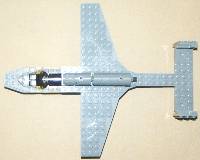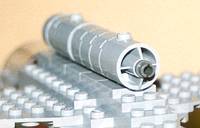 |
My Own Creations
Heinkel He-162A-2 Salamander |
 |
|
 |
 |
 |
|
 |
My Own Creations
Heinkel He-162A-2 Salamander |
 |
|
 |
 |
 |
|
|
The time has come to move into the jet age with a model
of a remarkable jet fighter that was developed in the closing stages of
World War II. But like most of the other advanced weapons it was too little,
to late. It was designed and flown within three months!
On September 8th 1944 the Reichsluftsfahrtministerium issued a requirement for a cheap and simple lightweight single seat jet fighter that was easy to build in large numbers within a very short time. It meant that the Volksjäger would have to be made from wood and other non-strategic materials, and have a simple structure capable of being manufactured by semi-skilled labour. The plane was to be easy to fly and the intention was to use Hitler Jugend pilots whose only previous flying experience was glider training and two prototypes of the He-162S tandem-seat training glider was in fact built. The aircraft was to be built in such quantities that a defective aircraft could simply be discarded and replaced with a new. Heinkel won the contract and the prototype flew on December 6th. But four days later it crashed when the starboard wing collapsed in midair. After the wings haad been restructured and given turned-down wingtips to reduce directional instability the next prototyes flew in mid-January 1945 and later that month the first pre-production aircraft was delivered to ErprobungsKommando 162 at Rechlin. In February I/Jagdgeschwader 1 "Oesau" began converting from FockeWulf-190s. But lack of fuel and attacks by USAAF delayed the training and the three sqaudrons only became operational on May 4th by which the II/JG 1 had also begun conversion. During the last hectic weeks of the war I/JG 1 only scored one confirmed kill for the loss of 10 pilots and 13 aircraft. Only 3 was lost in combat as most losses were from engine flame-outs, structural failures or dead-stick landings after running out of fuel. Despite this poor record, the difficulties was mostly due to the fact that it was rushed into production, not that it was a bad design. One experienced Luftwaffe pilot called it a "first class combat aircraft" and a British test pilot also praised it. By the end of hostilities 116 He 162s had been delivered with a further 200 awaiting flight testing and more than 800 were in various stages of assembly when the underground production centers were captured. As most other jets of that time the engine was placed well outside the fuselage. This simplyfied using more powerful engines or even using ramjets that could run on low grade fuel. But putting the engine in a nacelle on top off the fuselage gave the pilot a very bad "six-a-clock" view. It also dictated the use of double tailfins to make them stay clear of the exhaust. Baling out was clearly hazardous and the aircraft was fitted with an ejection seat. Weighing less than half of the Me262. I had to make to two compromises in the design: the tail is horizontal
and not slightly V-shaped as they should be. The other is more subtle:
I had to place the wheels of the main undercarriage one stud too far back
to make the balance right. I choose to make it light grey as if it was
not camouflage painted.
The He-162A-1 bomber destroyer was fitted with two MK-108 30 millimeter cannons but their recoil was too much for the lightweight airframe to absorb and production shifted to He-162A-2 air superiority fighter. The various changes resulted in an aircraft that weighed substantially more than specified but despite this it had a top speed that was 140 kph higher than called for. |
|||||||||||||||||
|
|
||||||||||||||||||
 |
The original... | |||||||||||||||||
 |
...and the model
I think this is the best picture of the model. The red is supposed to look like an arrow |
|||||||||||||||||
 |
Left view
You can just see the small gap in the engine at the front R2-D2 body |
|||||||||||||||||
 |
Top view
It was the shape of the wing plates that inspired me to make this model |
|||||||||||||||||
 |
Closeup of the cockpit
showing the inclined position of the pilot. Also visible is the door for the front wheel |
|||||||||||||||||
 |
Closeup of the engine
showing the exhaust made with a R2-D2 body and a technic pin |
|||||||||||||||||
|
|
||||||||||||||||||
| Blueprint | Technical Specifications | |||||||||||||||||
 |
|
|||||||||||||||||